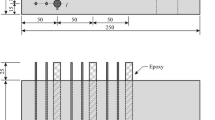Abstract
When an electrical field is applied to a cementitious material, the ions of its pore solution move to the cathodic and anodic electrodes. As a consequence, an acceleration of the leaching degradation process may cause the dissolution of the solid phases. Several researchchers have applied this kind of method to the study of the leaching of cementitious materials, but mainly on cement paste. The study of leaching in concretes by this method is more difficult as, on the one hand, the high resistivity of these materials implies a quite low intensity passing through the concrete even at high voltage applied and characterisation of the degraded zones is doubtful. In this paper, electrical fields are applied to determine the ability of these methods to characterise and classify ultra high performance concretes (UHPC). Three different mixes of UHPC have been submitted to a migration test in galvanostatic conditions, using granitic water as electrolyte, and analysing the resulting electrolytes and the solid sample by different techniques. As a reference, the results have been compared with those obtained by following the standard ANSI/ANS-16.1-1986 “Measurement of the leachability of solidified low-level radioactive wastes by a short term procedure”. From this research, it could be deduced that the migration method accelerates very much the leaching process and gives a longer-term classification of different mixes of concretes against the degradation by natural water. The research presented in this paper has been carried out as part of the research project named “UNICORN”, supported by the Basic BRITE-EURAM Program of the EU.
Résumé
Lorsque un champ électrique est appliqué à un matériel cimentaire, les ions de la solution qui se trouvent dans les pores se déplacent vers les cathodes et les anodes en provoquant une accélération des processus de dégradation par lixiviation. Plusieurs chercheurs ont appliqué ce type de méthode à l’étude de la lixiviation dans les matériaux cimentaires, mais surtout à la pâte de ciment. L’étude de la lixiviation dans les bétons en utilisant cette méthode est assez difficile, car d’une part, la grande résistivité de ces matériaux implique une faible intensité traversant le béton, même en appliquant des voltages élevés, et la caractérisation des zones dégradées est incertaine. Dans cet article, les champs électriques sont appliqués afin de déterminer la capacité pour cette méthode de caractériser et classifier les bétons d’ultra-haute performance (UHPC). Trois mélanges différents de UHPC ont été soumis à des essais de migration dans des conditions galvanostatiques, en utilisant de l’eau granitique comme électrolyte, et en analysant les électrolytes en résultant et les échantillons solides par diverses techniques. Comme référence, les résultats ont été comparés avec ceux obtenus selon la norme ANSI/ANS-16.1-1989. De cette étude, on pourrait déduire que la méthode de migration accèlère beaucoup les processus de lixiviation et donne à long terme une classification des différents mélanges de bétons en fonction de la dégradation par l’eau naturelle. La recherche présentée dans cet article fait partie d’un projet de recherche nommé UNICORN, et est supporté par le programme basique BRITE-EURAM de l’Union Européenne.
Similar content being viewed by others

References
Saito, H., Nakane, S., Ikari, S. and Fujiwara, A., ‘Preliminary experimental study on the deterioration of cementitious materials by an acceleration method’,Nuclear Engineering and Design 138 (1992) 151–155.
Faucon, P., Gerard, B., Jacquinot, J.F. and Marchand, J., ‘Water attack of a cement paste: towards an improved accelerated test?’,Advances in Cement Research 10 (2) (1998) 67–73.
Gérard, B., ‘Contribution des couplages mécanique-chimique-transfer dans la tenue à long terme des ouvrages de stockage de déchets radioactifs’, Doctoral thesis, Laboratoire de Mécanique et Technologie (E.N.S. de Cachan, C.N.R.S. Université Paris 6), Université Laval, Dpt. de Génie Civil C.R.I.B., Québec, Canada, (1996).
Kuroi, T. and Sueyoshi, T., ‘Softening phenomenon of cement paste due to action of electric current’,Semento Gijutsu Nenpo 41 (1987) 221–224.
Andrade, C., Castellote, M., Sarría, J., Alonso, C. and Menéndez, E., ‘Effect of electrochemical rehabilitation techniques in the porous microstructure of concrete’, International Conference on Corrosion and Rehabilitation of Reinforced Concrete Structures, Orlando, Florida (EEUU), December 1998.
Le Maréchal, J., Gérard, B., Marchand, J., Gagnon, J.-Ph. and Didry, O., ‘New accelerated leaching experiment: the LIFT procedure’, Proceedings of the Fourth CANMET/ACI/JCI International Conference, SP 179-55, Tokushima, Japan, 1998.
Castellote, M., Andrade, C. and Alonso, C., ‘Changes in the concrete pore size distribution due to electrochemical chloride migration trials’,ACI Materials Journal 96 (3) (May–June 1999) 314–319.
Saito, H. and Deguchi, A., ‘Leaching tests on different mortars using accelerated electrochemical method’,Cement and Concrete Research 30 (2000) 1815–1825.
Andrade, C., Sanjuán, M.A. and Alonso, C., ‘Measurement of chloride diffusion coefficient from migration tests’, The NACE Annual Conference and Corrosion Show., paper, no. 319, (1993).
Lagerblad, B., ‘Texture and chemistry of historic concrete subjected to prolonged hydratation’, Proceedings of the Workshop on water in cement paste and concrete hydration and pore structure, Skagen, Denmark, Ed. The Nordic Concrete Federation, 1999.
Author information
Authors and Affiliations
Additional information
Editorial Note Dr. Maria Cruz Alonso is a RILEM Senior Member and participates in the work of RILEM TC 178-TMC: ‘Testing and modelling chloride penetration in concrete’. Dr. Carmen Andrade is the President of RILEM and a RILEM Fellow. She is the Chairlady of RILEM TC 178-TMC. She also participates in RILEM TCs 185-ATC ‘Advanced testing of cement-based materials during setting and hardening’ and NEC ‘Non-destructive evaluation of the ‘covercrete’ (concrete cover)’. Dr. Castellote is a member of RILEM TC 178-TMC. The IETcc (CSIC) is a RILEM titular Member.
Rights and permissions
About this article
Cite this article
Castellote, M., Llorente, I., Andrade, C. et al. Accelerated leaching of ultra high performance concretes by application of electrical fields to simulate their natural degradation. Mat. Struct. 36, 81–90 (2003). https://doi.org/10.1007/BF02479521
Received:
Accepted:
Issue Date:
DOI: https://doi.org/10.1007/BF02479521



